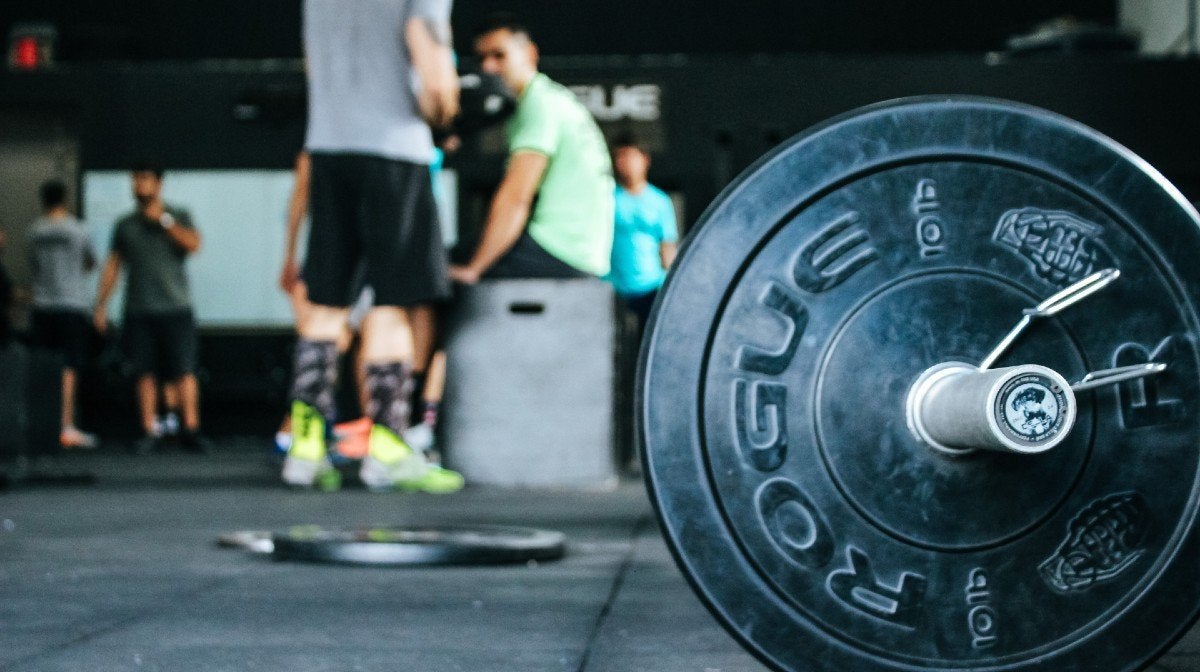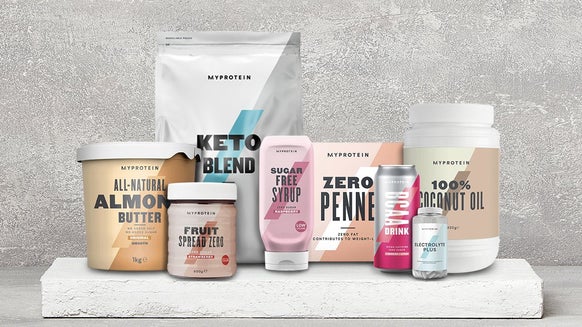Can You Build Muscle With Just A Barbell? The Only Equipment You’ll Need For The Gym

Following the announcement from No 10 giving the green light for gyms to re-open, it will be obvious that there have been some significant changes that could impact your preferred training style.
Many gyms are limiting their capacity, access to equipment and providing designated zones for individuals — to encourage social distancing. Limited access to equipment means getting your hands on a barbell could be your one-way ticket to making those post-lockdown gains. Here’s some advice on how you can build muscle using only a barbell.
Select the right weight. How heavy should your barbell be?
For now, it’s probably best to avoid attempting your old one-rep-max since gyms have re-opened – not only because social distancing rules may mean you can’t have a spotter, but because it’s unlikely you’ll be able to move the same weights that you were safely using pre-lockdown.
There’s plenty of evidence to suggest that your strength will have stuck around over the past 4-months, and if lost, it will return quickly with re-training, but it’s best to take it slow to stimulate your nervous system to return your muscular coordination and confidence with heavier weights.
Whether you’re new to the gym or returning, now may be the time to concentrate on training for hypertrophy (increase muscle size), as this type of training presents a low risk of injury (when proper technique is accounted for!) whilst also developing muscular size with considerable strength gains. Hypertrophy training involves using a rep range of between 8-12 repetitions whilst using loads around 60-80% of your one-rep-max. If you’re not familiar with your one-rep-max, then the weight should feel moderately heavy and you should feel fatigued (the burn!) once you reach your targeted number of repetitions, while feeling that you have around 3 more reps in the tank before failing.
Since hypertrophy is driven primarily by pushing yourself to (or close to) failure and the accumulation of overall training volume, it is appropriate to push yourself close to failure frequently – however, you should still regularly take rest days or de-load weeks to avoid overtraining syndrome.
Building muscle with a barbell
The barbell often seems like an advanced and intimidating tool, reserved for only the most experienced. Whether you are a newbie or a seasoned gym-veteran, the barbell should be your best friend. Once equipped with the right knowledge, the barbell can form the basis of any resistance-based workout, as it is the most versatile piece of equipment that is found universally in almost any gym.
The barbell provides access to an arsenal of compound exercises. Although each exercise has a specific target muscle group, compound lifts invariably work for other major muscle groups throughout the body, including synergists (smaller assistance muscles) that provide an essential role in stabilising joints.
Effective barbell-based workouts consist of around five to eight exercises, one or two of which would be the ‘main-lifts’ for that session, targeting desired muscle groups using compound lifts. Remaining exercises are considered ‘accessory-exercises’, consisting of low-load bodyweight and isolation (single-joint) exercises. These exercises facilitate the accumulation of more training load, and thus more stimulus promoting the need for new muscle tissue to grow. With only a barbell and plates available, consider using the barbell, individual plates or your bodyweight for the accessory exercises.
To optimise training, compound lifts should be included for 3-5 sets with around 90-seconds rest between sets and 8-12 reps of the moderately heavy load that causes noticeable muscular fatigue). With gyms promoting social distancing, it’s best to keep two or three reps in the tank so that you can avoid the need for a spotter and any risky gym-fails!
Barbell exercises to help you build muscle
1. Barbell Back Squat
Muscles Worked: Quadriceps, Calf Muscles, Glutes, Lower/Upper Back
Set & Reps: 4x10
Method: With the bar in the rack around two-inches below shoulder-height, take a comfortable and even grip-width – the narrower the grip, the more of a ‘shelf’ your upper back muscles create for the barbell to sit on. Your feet should be shoulder-width apart with toes at a slight outward angle, although this varies from person to person due to individual hip structure, so play around with what works for you! Once set up, squat the bar out of the rack and take one step back. Take a deep breath and brace your core as if you’re about to get punched (known as the Valsalva manoeuvre), providing support to your spine. Squat the weight down in a controlled manner, then stand back up. Rinse and repeat until the end of your set, then re-rack the barbell. You should ‘feel the burn’ in your quads and glutes throughout the lift.
Tip: If you struggle to hit depth, try experimenting with the bar placement on your back – a high-bar position is best suited to people with shorter femurs who can easily achieve a deep squat, while a low-bar position will help those with longer femurs.
2. Barbell Deadlift
Muscles Worked: Hamstrings, Calf Muscles, Glutes, Lower/Upper Back, Forearms
Set & Reps: 3x8
Method: Standing behind the centre of the barbell, grab the bar with an even grip (double-overhand/mixed-grip with/without straps). Lower your hips, keeping your spine neutral (straight). Pull the ‘tension’ out of the bar by applying force to the bar without lifting it from the floor. Maintaining a neutral spine, brace and extend your hips and knees until you reach the ‘lockout’ at the top. Lower the weight in a controlled way and repeat. You should feel the tension in your hamstrings and glutes throughout the lift.
Tip: Squeeze your shoulder blades together and downwards to help stabilise your spine. Don’t allow the angle of your spine to change throughout the lift.
3. Barbell Lunge (Accessory lift)
Muscles Worked: Quadriceps, Glutes, Lower/Upper Back
Set & Reps: 4x12
Method: With the barbell on your back the squat, step forward with one leg, landing in a lunge, but without allowing your rear-leg knee to touch the floor. Step up and back to the starting position before either alternating legs or completing the set on one leg before following with the opposite side.
Tip: Step slightly diagonally to widen your stance which will help with your balance.
4. Barbell Hip Thrust
Muscles Worked: Glutes, Hamstrings, Lower Back
Set & Reps: 4x8
Method: With your upper back on a bench, the barbell should be positioned in your hip crease. Hold the bar to stabilise it and extend your hips to the top of the lift before lowering down in a controlled way, then repeat until finished.
Tip: Use padding to reduce discomfort on any bony points of your hips.
5. Barbell Row
Muscles Worked: Upper/Lower Back, Biceps, Forearms
Set & Reps: 4x10
Method: Either supported by an inclined bench or standing (known as a ‘bent over row’ or ‘Pendlay row’), place your hands with an even grip on the bar. Pull the bar up to meet your torso before slowly lowering it back to the starting position.
Tip: Squeeze your shoulder blades together and think of trying to pull your elbows to the ceiling to get a good contraction from your upper back muscles.
6. Barbell Shoulder Press/Overhead Press
Muscles Worked: Deltoids, Triceps, Upper Back
Set & Reps: 5x8
Method: Starting with the same set-up as the squat, grab the bar in front of you with an even grip. Brace before un-racking, and squeeze your glutes to stabilise your lower back. Again, squeezing your shoulder blades together, push the bar overhead, moving your head out of the way as you go to avoid hitting your chin and to maintain a straight bar path. Slowly lower the bar back to the starting position (remember to move your head back out of the way of the bar on the way back down too!) and repeat.
Tip: If you find you need to ‘dip’ with your knees to help use momentum (known as a push-press) to get the bar up, it may be a good idea to lower the weight on the bar slightly.
7. Barbell Bench Press
Muscles Worked: Pectoral Muscles, Triceps, Lower Back, Abdominal Muscles, Quadriceps
Set & Reps: 4x10
Method: Get an even and comfortable grip of the bar, pinch your shoulder blades together and move your feet back on the floor (so that you can use ‘leg-drive’ for additional power during the press). Your points of contact should be your feet to the floor, and your glutes/upper back/head in contact with the bench. Create an arch in your back by engaging your lower back muscles to stabilise the spine. Liftoff from the rack, brace, lower the bar, press and repeat.
Tip: Start with your eyes in-line underneath the barbell when starting so that you don’t have to do a ‘lat-pullover’ to get the barbell over your chest.
8. Barbell Curl/Bicep Curl (Accessory lift)
Muscles Worked: Biceps, Forearms
Set & Reps: 5x8
Method: With an even grip on the barbell, squeeze your shoulder blades together before lifting the weight (without swaying to get the weight up). Lower the weight and repeat.
Tip: To get the most bang-for-your-buck, try standing barbell curls and bench supported barbell curls – the biceps brachii muscle flexes the shoulder as well as the elbow, so this means you should use different positions to place stress on the muscle at different lengths. Don’t curl in the squat rack unless you want to make some enemies.
Take Home Message
The barbell is an extremely versatile piece of equipment that can open the door to tonnes of new size and strength gains. Equipped with the right knowledge, anybody can make the most out of a limited gym.




